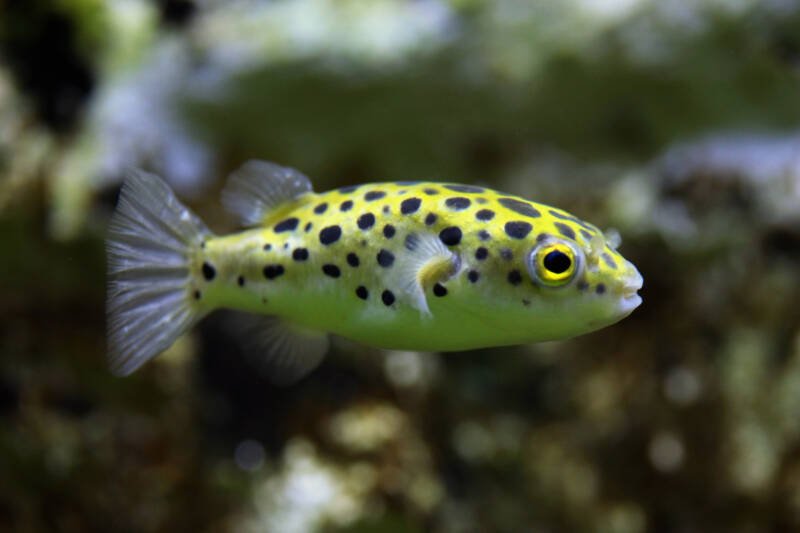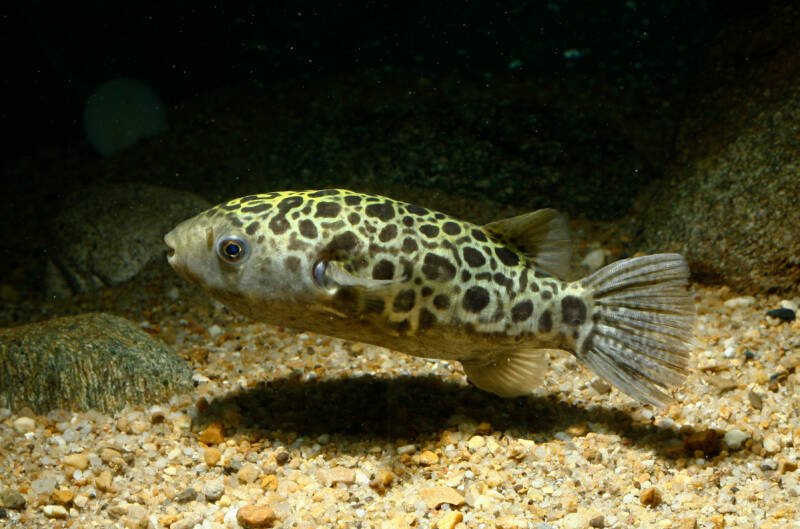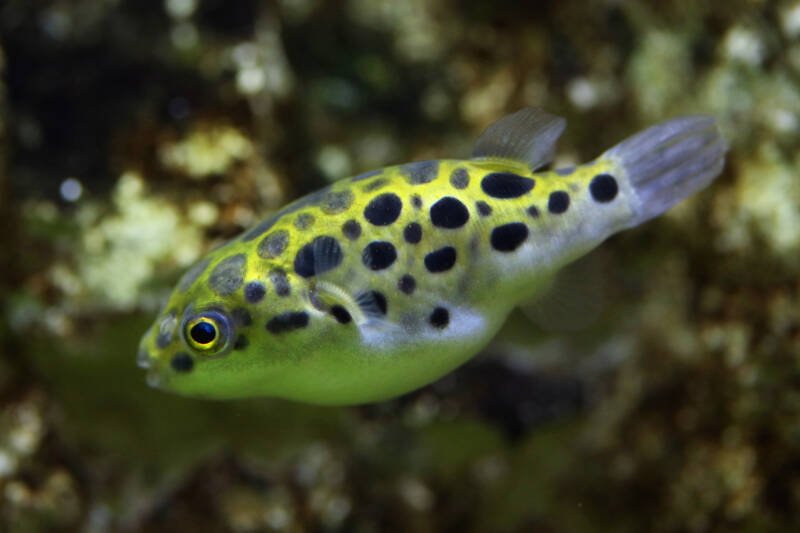When I think about freshwater or brackish pufferfish, I can’t help but think of the wonder they inspire.
They are known for their bizarre appearance, aggressive temperament and rough behavior.
But their reputation is not entirely deserved. Pufferfish are very interesting and unique creatures.
They have been around for thousands of years, and despite their reputation, they have been relatively overlooked by science. Because they are so unique, there is a lot to learn about them.
The green spotted puffer is one of the most active and playful puffer species. Let’s dive in and see what makes this rather unique-looking fish tick!

In this article
At a Glance
| Adult size: | 6 inches (15 cm) |
| Minimum tank size: | 55 gallons (200 l) |
| pH: | 8.0 |
| Diet: | omnivorous, mainly meat-based |
| Behavior: | aggressive |
| Habitat: | brackish |
Origins
The green spotted puffer (Tetraodon nigroviridis) is native to estuaries throughout Southern Asia.
This species spends their entire adult lives in brackish water, only going into freshwater to spawn.
The young live in freshwater only until they mature, and then they return back to the brackish waters along the coast, living the rest of their lives there.
Appearance

The markings and colors of the green spotted puffer have an uncanny resemblance to that of a leopard.
This fish’s pale yellow, slightly green body is dotted with irregular black spots. The belly is bright white.
A small mouth and two large eyes give this puffer a unique look. Their rounded body is very close to the shape of a blimp, only tapering at the small tail.
From a quick glance, the green spotted puffer seems to have no pectoral fins, but they’re there!
The pectoral fins are very small, translucent, and are only used for steering. Their tail is their sole method of propulsion.
This is one of the larger species of puffer that can reach a size of over 6.5 inches (16 cm)!
Did you know that the green spotted puffer has two ways to protect itself from predators?
One: They can inflate their stomachs, making themselves much larger and harder to eat.
Two: They secrete natural toxins in their bodies. If a predator is unfazed by their inflatable prey and still tries and goes in for a bite, they will surely regret it!
Behavior and Tankmates
Extremely aggressive and territorial, this puffer is best kept alone. Their strong teeth can take a chunk out of any tankmates.
Avoid unnecessary trauma and deaths. Do not house this puffer with any other fish or invertebrates.
Tank Setup
A large tank of at least 55 gallons (200 l) is what’s needed to properly house this puffer.
Being a brackish fish, the only way to keep them thriving through their ten-year lifespan is to only keep them in brackish setups.
You can get away with a specific gravity as low as 1.005, but you can also go as high as 1.015.
Also, a tropical fish temperature of 72°F-80°F (22-26°C) is required.
Having little tolerance for ammonia, nitrites, and nitrates, a fully cycled and regularly maintained aquarium is the best way to ensure the health of this animal.
In addition, they prefer a slightly higher pH of around 8.0.
The spotted puffer is a fan of having their own territory, so giving them plenty of plant cover, rocks, and hides gives them many different nooks to call home.
Twisted driftwood and roots not only add an interesting look to the tank but replicate some aspects of their natural environment.
These puffers are notoriously messy eaters! A good HOB (hang on back) or canister filter provides both mechanical and biological filtration.
That’s twice the cleaning power! These filters and regular water changes will help keep the tank and the puffer in tip-top shape!
Strong filters also aid in producing a decent current, which replicates the natural water flow they experience in the wild.
Food and Diet

The diet of wild green spotted puffer consists of invertebrates, mollusks, fish, and small worms and insects.
Since all GSP’s are wild-caught, it is important to replicate this diet as well as you can. Live options like feeder shrimp and snails provide both a good source of protein and enrichment.
Prey with decently strong shells should be offered regularly, as the regular munching will help the ever-growing teeth of the puffer stay at a healthy length.
Frozen options such as bloodworms, brine shrimp, and mysis shrimp can be fed as well.
And since this species is omnivorous, algae and other vegetable matter should be offered on occasion, but not too often as meat-based foods should be the majority of their diet.
Sexing and Breeding
Currently, there are no known ways to distinguish the sexes. Breeding this species in captivity is just as difficult.
No hobbyist has managed to successfully breed the green spotted puffer yet. Therefore, all specimens seen in the trade today are wild-caught.
Closing Thoughts
Puffers are some of the coolest fish out there! There are so many different kinds, and they’re all unique and amazing.
Remember to include lots of rocks and hiding places in their tank for them to explore, keep their water clean by doing regular water changes, and give them lots of healthy food!